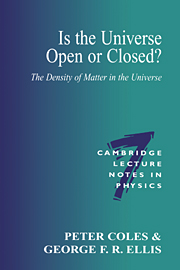8 - More realistic universe models
Published online by Cambridge University Press: 25 January 2010
Summary
Underlying what has been said above are some theoretical issues that remain unresolved, despite their importance for understanding the geometry of realistic universe models. The central feature is that the models on which the analysis above is based are the standard homogeneous and isotropic Friedman–Robertson–Walker (FRW) universe models; but the actual universe – from which our observations derive – is in fact inhomogeneous on small and intermediate scales.
Lumpy universe models
A series of related problems arise. The first point is that most methods of estimating Ω0 cannot determine the background model without simultaneously solving for its perturbations (for example, estimating velocity flows; calculating lensing effects; considering the effects of inhomogeneities on the CMB; and so on). Furthermore, there is a feedback from these inhomogeneities to the background model dynamics (and so to the equations whereby one estimates Ω0). But that raises the issue of gauge freedom in describing such perturbations, and how one chooses the background model when faced with a ‘lumpy’ real universe, which is the second main point.
The gauge issue has been intensively studied in recent years by Bardeen (1980), Ellis & Bruni (1989) and many others; see, e.g., Bruni, Dunsby & Ellis (1992) for a summary and references. The question here relates to the task of finding a description of inhomogeneities that does not depend on the way the background model is mapped to the real universe. The converse problem of the optimal way to fit a background FRW model to the real lumpy universe (Ellis & Stoeger 1987) has been the subject of much less thought.
- Type
- Chapter
- Information
- Is the Universe Open or Closed?The Density of Matter in the Universe, pp. 181 - 192Publisher: Cambridge University PressPrint publication year: 1997



